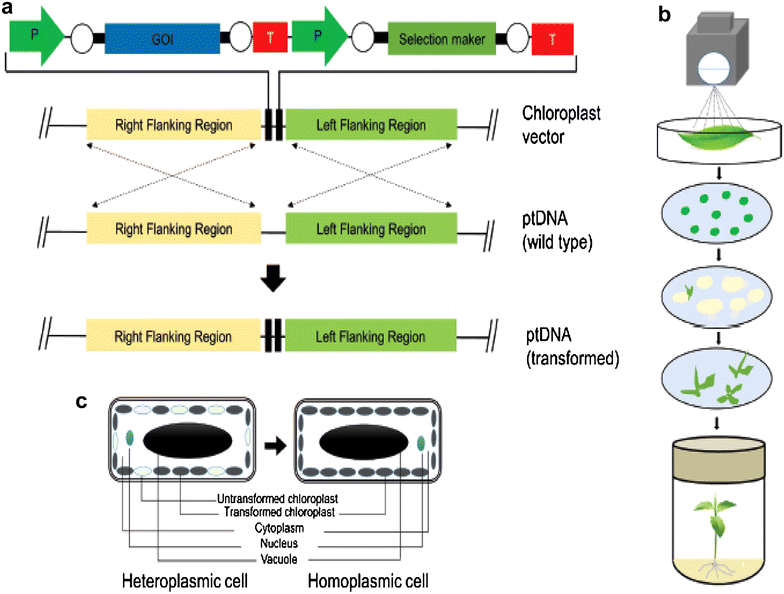Recent achievements obtained by chloroplast transformation
- PMID: 28428810
- PMCID: PMC5395794
- DOI: 10.1186/s13007-017-0179-1
Recent achievements obtained by chloroplast transformation
Abstract
Chloroplasts play a great role for sustained wellbeing of life on the planet. They have the power and raw materials that can be used as sophisticated biological factories. They are rich in energy as they have lots of pigment-protein complexes capable of collecting sunlight, in sugar produced by photosynthesis and in minerals imported from the plant cell. Chloroplast genome transformation offers multiple advantages over nuclear genome which among others, include: integration of the transgene via homologus recombination that enables to eliminate gene silencing and position effect, higher level of transgene expression resulting into higher accumulations of foreign proteins, and significant reduction in environmental dispersion of the transgene due to maternal inheritance which helps to minimize the major critic of plant genetic engineering. Chloroplast genetic engineering has made fruit full progresses in the development of plants resistance to various stresses, phytoremediation of toxic metals, and production of vaccine antigens, biopharmaceuticals, biofuels, biomaterials and industrial enzymes. Although successful results have been achieved, there are still difficulties impeding full potential exploitation and expansion of chloroplast transformation technology to economical plants. These include, lack of species specific regulatory sequences, problem of selection and shoot regeneration, and massive expression of foreign genes resulting in phenotypic alterations of transplastomic plants. The aim of this review is to critically recapitulate the latest development of chloroplast transformation with special focus on the different traits of economic interest.
Keywords: Chloroplast transformation; Homologus recombination; Novel traits; Regulatory sequences; Transgene.
Figures

Similar articles
-
Chloroplast genetic engineering via organogenesis or somatic embryogenesis.Methods Mol Biol. 2006;323:245-62. doi: 10.1385/1-59745-003-0:245. Methods Mol Biol. 2006. PMID: 16739583
-
A protocol for expression of foreign genes in chloroplasts.Nat Protoc. 2008;3(4):739-58. doi: 10.1038/nprot.2007.522. Nat Protoc. 2008. PMID: 18388956
-
Advances in chloroplast engineering.J Genet Genomics. 2009 Jul;36(7):387-98. doi: 10.1016/S1673-8527(08)60128-9. J Genet Genomics. 2009. PMID: 19631913 Review.
-
Breakthrough in chloroplast genetic engineering of agronomically important crops.Trends Biotechnol. 2005 May;23(5):238-45. doi: 10.1016/j.tibtech.2005.03.008. Trends Biotechnol. 2005. PMID: 15866001 Free PMC article. Review.
-
[Advances in chloroplast expression of recombinant proteins in higher plants].Sheng Wu Gong Cheng Xue Bao. 2018 May 25;34(5):631-643. doi: 10.13345/j.cjb.170427. Sheng Wu Gong Cheng Xue Bao. 2018. PMID: 29893071 Review. Chinese.
Cited by
-
Transfer and Expression of Native Human Insulin-Like Growth Factor-1 in Tobacco Chloroplasts.Iran J Biotechnol. 2021 Oct 1;19(4):e2911. doi: 10.30498/ijb.2021.256630.2911. eCollection 2021 Oct. Iran J Biotechnol. 2021. PMID: 35350639 Free PMC article.
-
Decoding the chloroplast genomes of five Iranian Salvia species: insights into genomic structure, phylogenetic relationships, and molecular marker development.BMC Genomics. 2025 May 30;26(1):545. doi: 10.1186/s12864-025-11729-0. BMC Genomics. 2025. PMID: 40448040 Free PMC article.
-
Vacuum/Compression Infiltration-mediated Permeation Pathway of a Peptide-pDNA Complex as a Non-Viral Carrier for Gene Delivery in Planta.Sci Rep. 2019 Jan 22;9(1):271. doi: 10.1038/s41598-018-36466-1. Sci Rep. 2019. PMID: 30670735 Free PMC article.
-
Advances in plastid transformation for metabolic engineering in higher plants.aBIOTECH. 2022 Oct 1;3(3):224-232. doi: 10.1007/s42994-022-00083-4. eCollection 2022 Sep. aBIOTECH. 2022. PMID: 36313931 Free PMC article. Review.
-
Imaging of the Entry Pathway of a Cell-Penetrating Peptide-DNA Complex From the Extracellular Space to Chloroplast Nucleoids Across Multiple Membranes in Arabidopsis Leaves.Front Plant Sci. 2021 Dec 3;12:759871. doi: 10.3389/fpls.2021.759871. eCollection 2021. Front Plant Sci. 2021. PMID: 34925409 Free PMC article.
References
Publication types
LinkOut - more resources
Full Text Sources
Other Literature Sources

